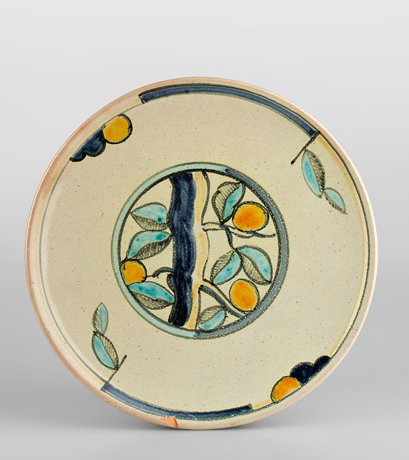
Pottery from Eysins in CERAMICA CH
Roland Blaettler, 2019
Having completed a two-year course at the Swiss School of Ceramics in Chavannes-près-Renens between 1916 and 1918, Paul Gerber (1900–1977) perfected his skills in throwing and plaster-of-Paris casting in Langenthal, Steffisburg and the Jura region. After that, he worked as a thrower for the Charolles faience manufactory (Saône-et-Loire, France). In July 1921 he joined the Poteries du Sornin in Saint-Maurice-lès-Châteauneuf (Saône-et-Loire). Set up in April 1920, this manufactory was managed by Maurice Dagot, whose sister Berthe Paul Gerber married in August 1923.
The new enterprise constantly had to contend with serious financial difficulties, as it struggled to compete with rival businesses, in particular the Charolles faience manufactory. In November 1923, the shareholders decided to cease production and only finish decorating the biscuit-fired pieces that were still in stock. Gerber found a job as a modeller and thrower with Hippolyte Boulenger & Cie, a refined white earthenware factory in Montereau (Yonne, France). From 1st February 1924 to 30th November 1925, he held the post of technical director at the faience manufactory of Charles Briand in Charolles (Duroy – see sources below).
Liquidation of the company Poteries du Sornin was announced in January 1924. While the building and property were sold in 1925, Gerber purchased the stock of undecorated wares. He subsequently attempted to resume production, probably by renting the old equipment. The experiment, however, did not last long, and in April/May 1926, the Sornin kilns were shut down for the last time. From 20th May 1926, Gerber is known to have been in Chauvigny-sur-Vienne in the Poitou region of France, where he found employment at the porcelain factory of Fernand Deshoulières (Duroy – see sources below).
Upon his return to Switzerland in 1928, he was temporarily employed as a substitute technical instructor at the Swiss School of Ceramics (Le Droit du Peuple dated 17th April 1928, 5). He obviously remained in this post until 1930/31, as he is listed as “maître” (master/technical instructor) in the Annuaire Vaudois phonebook’s listing for the school from 1929 to 1931. According to a biography written by his grandson Christian Gerber, he moved to Ferney-Voltaire in 1930, before eventually settling in Carouge. On 19th September 1931, the Schweizerisches Handelsamtsblatt (Swiss Official Gazette of Commerce) listed him as CEO of the company “Paul Gerber – Commerce et fabrication de produits céramiques” (trade and production of ceramic products) with its headquarters at 48 Rue Jacques-Dalphin in Carouge (SOGC, Vol. 49, 1931, 2057).
A few months later, in June 1932, the company name was struck off the register as the company purpose had expired (SOGC, Vol. 50, 1932, 1634). It is quite unlikely that Gerber could have set up a production line within such a short space of time. Did he perhaps restrict himself to trading in other potters’ wares? After a short stay in Aubonne, where, again according to Christian Gerber, he had a pottery shop, he moved to Nyon. There, he opened a new business together with Robert Knecht, owner of the Knecht Pottery in Ferney-Voltaire (Ain), under the name “Knecht et Gerber”, specialising in the sale of pottery, faience, porcelain and glass. The business address was 43 rue de Rive (SOGC, Vol. 52, 1934, 2307). Knecht was probably hoping to extend his sales area to Switzerland, and this may also have been the motivation behind the brief business period in Carouge mentioned above.
Following this sequence of diverse and often complex episodes, Paul Gerber and his family finally unpacked their suitcases permanently in Eysins, not far from Nyon, in 1936. The company name “Knecht et Gerber” was struck off the register on 17th August 1938, and the assets and liabilities were acquired by the company “Poterie d’Eysins Paul Gerber”, which was officially listed on the same day (SOGC, Vol. 56, 1938, 1912). Paul Gerber was finally able to settle into his own workshop in Eysins, which was complete with a wood-burning kiln that was constructed to his specifications.
Surrounded by a small workforce which included his son Edmond, Gerber developed a production line of slipped earthenware and faience, which attested to the knowledge and skills that he had acquired, particularly with regard to the properties of glaze and the shaping of his products. Economic pressure often forced him to concentrate on normal everyday wares (MHPN MH-2000-127; MHPN MH-1993-22), to the detriment of his creative work, which he obviously had a flair for (MHPN MH-2000-71; MHPN MH-2000-173A). Like many of his fellow potters at the time, Gerber too produced commemorative objects (ML 2020-28-1; MHPN MH-FA-4615; MHPN MH-FA-4662; MHPN MH-1993-14; MHPN MH-2000-62) and souvenirs for tourists (MHPN MH-1993-13). His regular clients included Genevan florists and confectioners, rural grocery shops as well as department stores. Even when producing large series, Gerber remained true to his craftsman’s manufacturing methods, which he continued to use almost up to the day he died.
Translation Sandy Haemmerle
Sources:
Collection of documents assembled by Christian Gerber on the website www.notrehistoire.ch (search term “Paul Gerber”)
Daniel Duroy, Les faïences du Sornin (http://pjpmartin.free.fr/Chf15/Chf15_DD.pdf, last accessed May 2019)
The Swiss Official Gazette of Commerce (available on e-periodica.ch)
The press and directories of the Canton of Vaud, accessed via the Scriptorium website of the Cantonal and University Library in Lausanne

